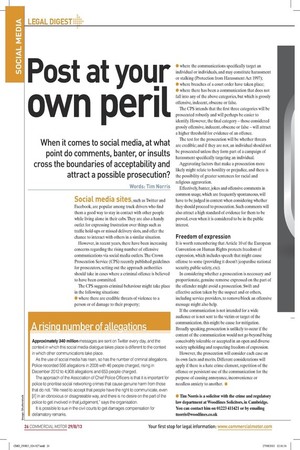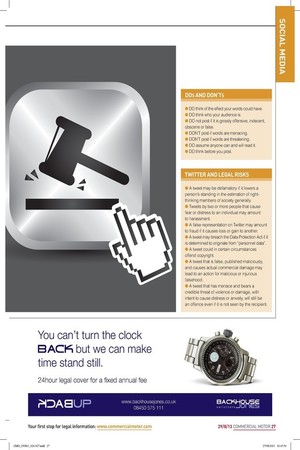Post at your own peril
Page 21

Page 22

If you've noticed an error in this article please click here to report it so we can fix it.
When it comes to social media, at what point do comments, banter, or insults cross the boundaries of acceptability and attract a possible prosecution? Words: Tim Norris
Social media sites, such as Twitter and Facebook, are popular among truck drivers who find them a good way to stay in contact with other people while living alone in their cabs. They are also a handy outlet for expressing frustration over things such as traffic hold-ups or missed delivery slots, and offer the chance to interact with others in a similar situation.
However, in recent years, there have been increasing concerns regarding the rising number of offensive communications via social media outlets. The Crown Prosecution Service (CPS) recently published guidelines for prosecutors, setting out the approach authorities should take in cases where a criminal offence is believed to have been committed. The CPS suggests criminal behaviour might take place in the following situations: • where there are credible threats of violence to a person or of damage to their property; • where the communications specifically target an individual or individuals, and may constitute harassment or stalking (Protection from Harassment Act 1997); • where breaches of a court order have taken place;
• where there has been a communication that does not fall into any of the above categories, but which is grossly offensive, indecent, obscene or false.
The CPS intends that the first three categories will be prosecuted robustly and will perhaps be easier to identify. However, the final category — those considered grossly offensive, indecent, obscene or false — will attract a higher threshold for evidence of an offence.
The test for the prosecution will be whether threats are credible; and if they are not, an individual should not be prosecuted unless they form part of a campaign of harassment specifically targeting an individual.
Aggravating factors that make a prosecution more likely might relate to hostility or prejudice, and there is the possibility of greater sentences for racial and religious aggravation.
Effectively, banter, jokes and offensive comments in common usage, which are frequently spontaneous, will have to be judged in context when considering whether they should proceed to prosecution. Such comments will also attract a high standard of evidence for them to be proved, even when it is considered to be in the public interest. Freedom of expression
It is worth remembering that Article 10 of the European Convention on Human Rights protects freedom of expression, which includes speech that might cause offense to some (providing it doesn't jeopardise national security, public safety, etc).
In considering whether a prosecution is necessary and proportionate, genuine remorse expressed on the part of the offender might avoid a prosecution. Swift and effective action taken by the suspect and or others, including service providers, to remove/block an offensive message might also help.
If the communication is not intended for a wide audience or is not sent to the victim or target of the communication, this might be cause for mitigation. Broadly speaking, prosecution is unlikely to occur if the content of the communication would not go beyond being conceivably tolerable or accepted in an open and diverse society upholding and respecting freedom of expression. However, the prosecution will consider each case on its own facts and merits. Different considerations will apply if there is a hate crime element, repetition of the offence or persistent use of the communication for the purpose of causing annoyance, inconvenience or needless anxiety to another. • • Tim Norris is a solicitor with the crime and regulatory law department at Woodfines Solicitors, in Cambridge. You can contact him on 01223 411421 or by emailing tnorris@woodfines.co.uk An in nm r f t i n
Approximately 340 million messages are sent on Twitter every day, and the context in which this social media dialogue takes place is different to the context in which other communications take place.
As the use of social media has risen, so has the number of criminal allegations. Police recorded 556 allegations in 2008 with 46 people charged, rising in December 2012 to 4,908 allegations and 653 people charged.
The approach of the Association of Chief Police Officers is that it is important for police to prioritise social networking crimes that cause genuine harm from those that do not. "We need to accept that people have the right to communicate, even [if] in an obnoxious or disagreeable way, and there is no desire on the part of the police to get involved in that judgement," says the organisation.
It is possible to sue in the civil courts to get damages compensation for defamatory remarks. DOS AND DON'TS
• DO think of the effect your words could have. ID DO think who your audience is.
• DO not post if it is grossly offensive, indecent, obscene or false.
• DON'T post if words are menacing.
• DON'T post if words are threatening.
• DO assume anyone can and will read it.
• DO think before you post.
• A tweet may be defamatory if it lowers a person's standing in the estimation of rightthinking members of society generally.
• Tweets by two or more people that cause fear or distress to an individual may amount to harassment.
• A false representation on Twitter may amount to fraud if it causes loss or gain to another.
• A tweet may breach the Data Protection Act if it is determined to originate from "personnel data".
• A tweet could in certain circumstances offend copyright.
• A tweet that is false, published maliciously, and causes actual commercial damage may lead to an action for malicious or injurious falsehood.
• A tweet that has menace and bears a credible threat of violence or damage, with intent to cause distress or anxiety, will still be an offence even if it is not seen by the recipient.













































